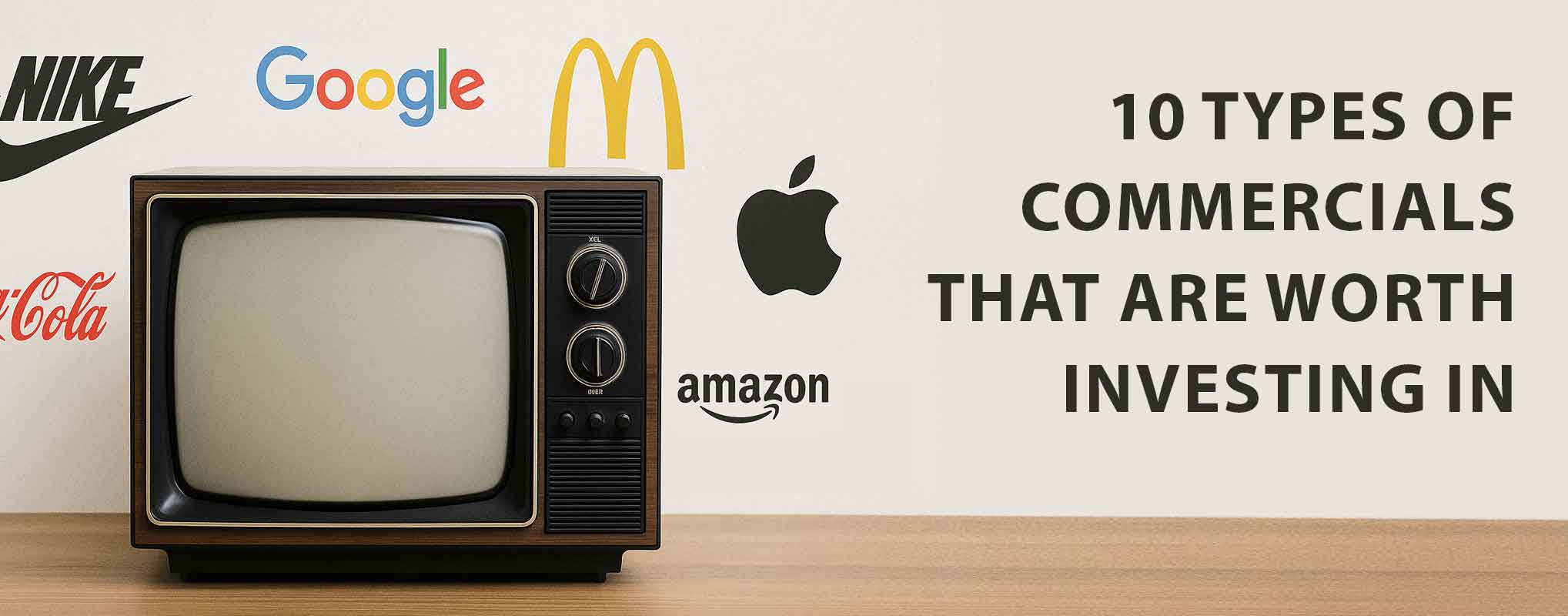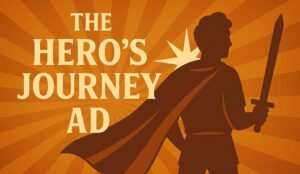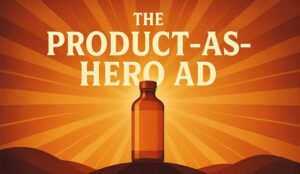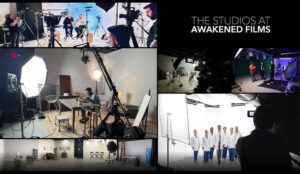
Frame by Frame
The Art and Science of Stellar Storytelling

By Jason Schuler on August 15, 2025

A lot has changed in advertising over the past decade. Platforms rise and fall. Formats evolve. Trends fade. However, certain types of commercials continue to be effective, not because of where they air, but because of how they make people feel.
These 10 types of TV Ads still get results in 2025 — because they’re grounded in human psychology, contain a unique creative spark, and are centered around the kind of storytelling that people actually care about.
Despite new tools and faster media cycles, the fundamentals haven’t changed. Research from the IPA (Institute of Practitioners in Advertising) shows that emotional campaigns are more than twice as effective as rational ones over the long term. And while AI, automation, and targeting have reshaped how ads are delivered, the ads that actually perform, that is the ones that get remembered, & shared, are still built on human insight and creative precision.
We’ve been asked hundreds and hundreds of times, “What type of commercial should we invest in”? And we have built our whole business around telling stories that move people. This article is designed to help marketers and brand managers challenge their thinking around video marketing.
This list isn’t about channels or distribution methods. It’s about the approach. These 10 ad styles are versatile, time-tested, and still driving results in 2025 and beyond; because they tap into something deeper than trends. Whether you’re producing a national TV spot, a social campaign, or a product video for your landing page, the best ideas start with a format that fits your message…and a story that sticks.
 1. The Hero’s Journey Ad
1. The Hero’s Journey AdAt its core, every great story is a transformation. This ad style introduces a character (or brand) facing a challenge. Then it shows the journey to overcome it.
Why it works:
Stories like this are deeply familiar. They create emotional stakes and a clear arc of change.
Examples:
Best for:
Brand storytelling, nonprofit campaigns, or origin stories.
Ideal uses:
Use a Hero’s Journey ad when you need your target audience to feel something deeper than a sales pitch. This style is ideal when the goal is to build brand trust, change perception, or show real transformation over time. It’s not about speed — it’s about resonance. If you’re telling the story of a founder overcoming setbacks, a patient’s recovery, a customer whose life changed thanks to your product, or a community that
rallied together, the Hero’s Journey format gives that story the space it needs to land. It frames your offering not as a quick fix, but as a meaningful catalyst for change.
This approach works especially well in longer-form content (60 seconds or more) where the pacing can breathe and the arc can unfold. It’s a great fit for nonprofit appeals, brand films, patient testimonials, and high-level recruiting. The key is to keep the focus on the person, not the brand. Let the viewer see themselves in the hero’s shoes. When done right, this type of ad doesn’t just explain what you do… it shows why it matters.
This is the workhorse of advertising. Identify the pain point fast. Then deliver the answer with clarity and confidence.
Why it works:
People want relief. If your product solves a real problem, show it in action.
Examples:
Best for:
SaaS, healthcare, services, or anything where benefits beat features.
Ideal uses:Use a Problem/Solution ad when clarity and speed matter more than emotion. This format is built for direct-response marketing, where the viewer has a pain point, and your job is to show the fix — fast. It works best when the audience is already aware of the problem and looking for options. Think clogged drains, clunky workflows, wasted time, or rising costs. The structure is simple but powerful: identify the problem in plain language, introduce your solution, and then prove it works.
This style is especially effective for products or services with clear, tangible benefits. It performs well in shorter spots (15 to 30 seconds) and can scale across platforms from TV to pre-roll to social. The magic is in the specificity. Skip the fluff. Show the messy before and the smooth after. If your offer really delivers, the Problem/Solution format lets it shine without distractions. It’s not flashy, but it converts.

Sometimes the product is the hero. These ads center the item or service, letting its utility, design, or impact shine.
Why it works:
It’s direct. You’re not selling a feeling… you’re showing what it does.
Examples:
Best for:
Consumer goods, medical devices, tools, and tech.
Ideal uses:
Use a Product-as-Hero ad when the strength of your offering *is* the story. This approach puts the product front and center; not as a passive object, but as an active problem-solver. It’s ideal when your product has unique features, sleek design, or can demonstrate value in action. Rather than relying on emotion or metaphor, these ads win by showing exactly how something works, how fast it works, or how satisfying it is to use. If people will say “I want that” just by watching it, this is your format.
These ads are often visual-first and benefit from strong production design, clear framing, and purposeful motion. Think time-lapse installs, slow-motion impacts, and tight shots that highlight texture, movement, or transformation. This style is especially effective for physical products, tech, tools, home goods, and health devices…anywhere performance or usability matters. Done right, a Product-as-Hero ad turns a demo into desire.
Let your customers, employees, or community do the talking. Layer real voices into one cohesive message.
Why it works:
It builds trust. And it showcases diversity of experience in a compact, human way.
Examples:
Best for:
Recruitment, client success, donor relations, and healthcare.
Ideal uses:
Use a Testimonial Montage ad when trust is the goal. This format weaves together multiple real voices into a cohesive, emotionally grounded narrative. Think: customers, employees, patients, donors, or partners…etc. It’s especially powerful when your story isn’t just one person’s experience, but a consistent theme echoed across many. Hearing the same message from different people, in their own words and tones, builds credibility and conveys scale. It shows that your impact isn’t anecdotal; it’s repeatable.
This style works beautifully for recruitment campaigns, donor engagement, client success stories, and brand credibility reels. It can be buttoned-up or unscripted, polished or raw, depending on your audience. And while it often pairs well with B-roll, sometimes the faces alone are enough. The key is honesty. Don’t over-produce or spoon-feed the message. Let the voices speak for themselves, then cut for rhythm, variety, and emotional arc. When it lands, a good testimonial montage feels less like an ad and more like the truth.
 5. The Aspirational Lifestyle Ad
5. The Aspirational Lifestyle AdThis isn’t about selling the product. It’s about selling who you become when you use it.
Why it works:
People want to see themselves at their best. This type of ad is about identity, not features.
Examples:
Best for:
Luxury, fitness, beauty, apparel, and personal development brands.
Ideal uses:
Use an Aspirational Lifestyle ad when you’re not just selling a product — you’re selling a feeling, an identity, or a way of life. This format works best when your audience wants to *become* something: stronger, more stylish, more successful, more connected. These ads show the end result, not the features. They rarely mention specs or pricing. Instead, they tap into desire. Think wide shots, slow motion, confident body language, and aspirational sound design — all designed to say, “This could be you.”
This approach is ideal for fashion, fitness, wellness, luxury, and high-ticket DTC brands. It’s also powerful for emerging products trying to create new categories. The trick is subtlety. You don’t push…you let people see themselves in the world you’ve created. This format can feel like a mood piece or a cinematic montage, but it works when it aligns with the audience’s goals. If your brand offers more than just utility, that is, if it says something about who someone is, then this is your format.
These ads teach. They clarify. They make complex things feel doable.
Why it works:
If someone’s confused, they won’t convert. Explainers remove friction.
Examples:
Best for:
B2B, fintech, SaaS, healthcare, or education.
Ideal uses:
Use an Explainer Ad when your product, service, or process isn’t instantly intuitive. This style breaks things down step-by-step — often with visual aids, animation, or a clear voiceover — to make the unfamiliar feel simple. It’s perfect for complex offerings that need just a bit of context to click. Instead of leading with emotion or identity, you lead with clarity. What is it? How does it work? Why should I care? If your audience is curious but confused, this is how you earn their trust.
Explainer ads are especially useful for B2B, SaaS, fintech, healthcare, and education — any space where the “aha moment” requires a little setup. They can live on landing pages, run as paid ads, or be embedded in sales decks and onboarding flows. The key is making it digestible. Keep the pacing tight, use metaphor or motion to simplify abstract ideas, and focus on what matters most to your viewer. Done well, an explainer doesn’t just inform — it converts.
 7. The UGC-style Ad
7. The UGC-style AdLooks lo-fi on purpose. Think selfie cams, raw edits, and first-person energy.
Why it works:
It feels authentic. It mimics what real people post — not what brands try to sell.
Examples:
Best for:
Social campaigns, product launches, and ecommerce.
Ideal uses:
Use a UGC-style ad when authenticity is more important than polish. These ads mimic real user content — filmed vertically, framed casually, and often delivered in selfie mode. They’re meant to feel organic, not produced. The goal is to blend in with the feed and build trust through relatability. This style is perfect when your audience is skeptical of traditional advertising or when your product shines best in the hands of real people. It’s also great for younger demos who prioritize peer validation over brand authority.
UGC-style ads work especially well for ecommerce, beauty, wellness, tech gadgets, and lifestyle brands. They’re effective for product launches, reviews, and first impressions. You can source real content from customers or work with creators to replicate the vibe — just avoid anything that feels scripted or overly rehearsed. The key is credibility. If it looks too perfect, it loses power. If it feels like someone’s genuinely excited to share… people pay attention.
It’s a story, but compact. There’s a setup, a moment of tension, and a satisfying payoff — all in under 60 seconds.
Why it works:
It earns attention by making you care… fast.
Examples:
Best for:
Creative campaigns, PSAs, or brand refreshes.
Ideal uses:
Use a Micro-Drama ad when you want to tell a story that grabs attention fast and delivers emotional payoff in under a minute. This style works by creating a miniature world: a quick setup, a moment of tension, and a clear resolution. It feels like a short film but moves like an ad. The characters, pacing, and visuals are all dialed in to make the viewer care *just enough* — and then hit them with something funny, touching, or unexpected. It’s storytelling with a stopwatch.
Micro-Drama ads are ideal for campaigns that aim to entertain or provoke thought while still tying back to your product or cause. This type of commercial is perfect for PSAs, cause marketing, brand awareness, and even clever product intros. The key is to start in the middle of something — no slow builds, no long explanations. Get to the conflict, then give us a satisfying turn. And if it feels like something people would want to rewatch or share? You’ve nailed it.
 9. The Funny-but-True Ad
9. The Funny-but-True AdSelf-awareness wins. These ads exaggerate reality in a way that makes people laugh… and nod.
Why it works:
Humor lowers resistance. It also helps you get remembered.
Examples:
Best for:
Challenger brands, startups, and anything needing a fresh voice.
Ideal uses:
Use a Funny-but-True ad when you want to entertain your audience while still delivering a real insight. These ads exaggerate everyday problems, poke fun at common habits, or lean into self-aware humor — all while keeping one foot grounded in truth. It’s not comedy for the sake of it. It’s comedy with a purpose. If people are nodding *and* laughing, you’re doing it right. This style is especially effective when your brand can afford to be playful or wants to disrupt a crowded category with a fresh voice.
Funny-but-True ads work across industries, from B2C products to services, apps, and even healthcare. They thrive on contrast: dramatic visuals paired with mundane frustrations, or deadpan delivery of absurd claims. Think mockumentaries, fake testimonials, or over-the-top reenactments of everyday annoyances. The key is timing and tone. It has to feel self-aware, not smug. And if your audience feels like you’re laughing *with* them — not at them — the humor becomes a bridge, not a barrier.
These ads use music, imagery, and motion to speak without words. No voiceover. No dialogue. Just feeling.
Why it works:
It’s universally understood. And in a sea of noise, silence can stand out.
Examples:
Best for:
Events, large-format screens, in-store loops, or brand films.
Ideal uses:
Use a Visual-Only ad when your message transcends language — or when you want to evoke a feeling without saying a word. These ads rely on imagery, pacing, movement, and music to tell the story. No voiceover. No dialogue. Just visual rhythm and emotional tone. This style works beautifully when your product or message can be experienced, not just explained. It’s especially powerful for global campaigns, in-store loops, large-format displays, or anything designed to be felt more than analyzed.
Visual-only ads are a strong choice for lifestyle brands, performance products, arts and entertainment, or anything where aesthetics and emotion do the heavy lifting. Think slow-motion, time-lapse, expressive lighting, or metaphor-driven sequences. The absence of narration gives the viewer room to project their own meaning — which makes the connection more personal. Just be sure every shot earns its place. When words are stripped away, every frame has to speak.
 A Quick Word on AI in Advertising
A Quick Word on AI in AdvertisingAI tools are everywhere in 2025 — and they can absolutely speed up production, repurposing, and A/B testing. For things like writing quick copy variants, resizing visuals or building quick and dirty storyboards, AI is a huge time saver.
But for story-driven content, it’s still no substitute for real insight. The best ads don’t just sound human. They’re rooted in lived experience, emotional truth, and cultural context.
Use AI to support your creative. Never let it replace your voice.
For all the buzz around what’s next, the truth is… some things don’t change. When your ad is well-crafted and emotionally grounded, it works no matter what year it is.
While AI can help you automate tasks and generate quick variations, it can’t replace the human instinct for nuance, timing, and emotional depth. That’s where real creative still wins. Because people don’t remember ads that follow trends. They remember ads that speak to them. The kind that feel less like noise and more like truth.
You don’t need to chase trends to make ads that work. These types of advertisements continue to perform not because of an algorithm, but because they speak to something real.
If that’s the kind of work you want to make, we’d love to help. At Awakened Films, we build story-first advertising that resonates. Whether it’s 15 seconds or fifteen minutes, our commercials and brand films drive business growth.
Let’s make something people actually want to watch.
People Also Ask: Commercial Video Production in New Jersey
Read on to learn about the types of advertisements that work in 2025: https://awakenedfilms.com/types-of-advertisement/